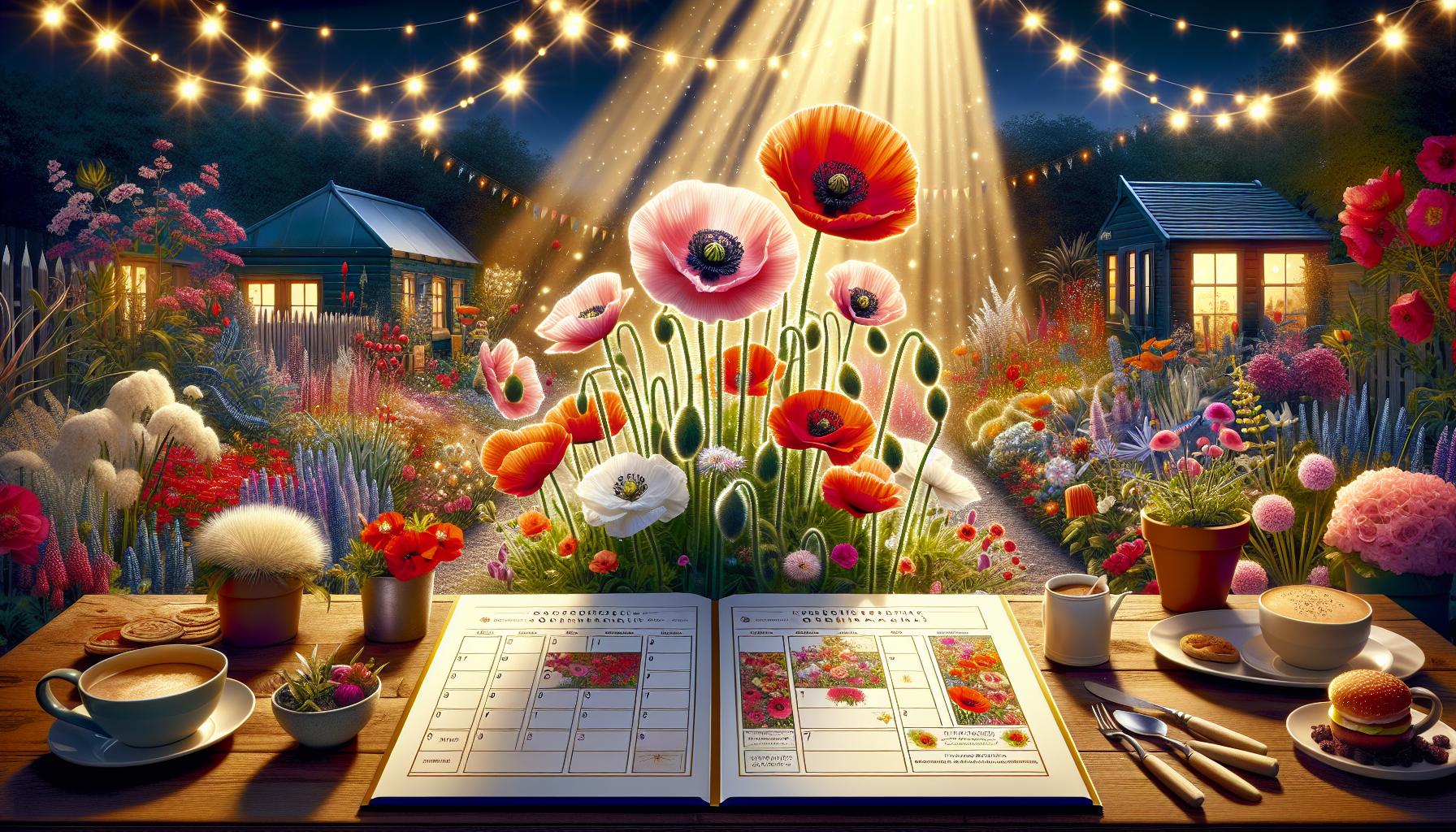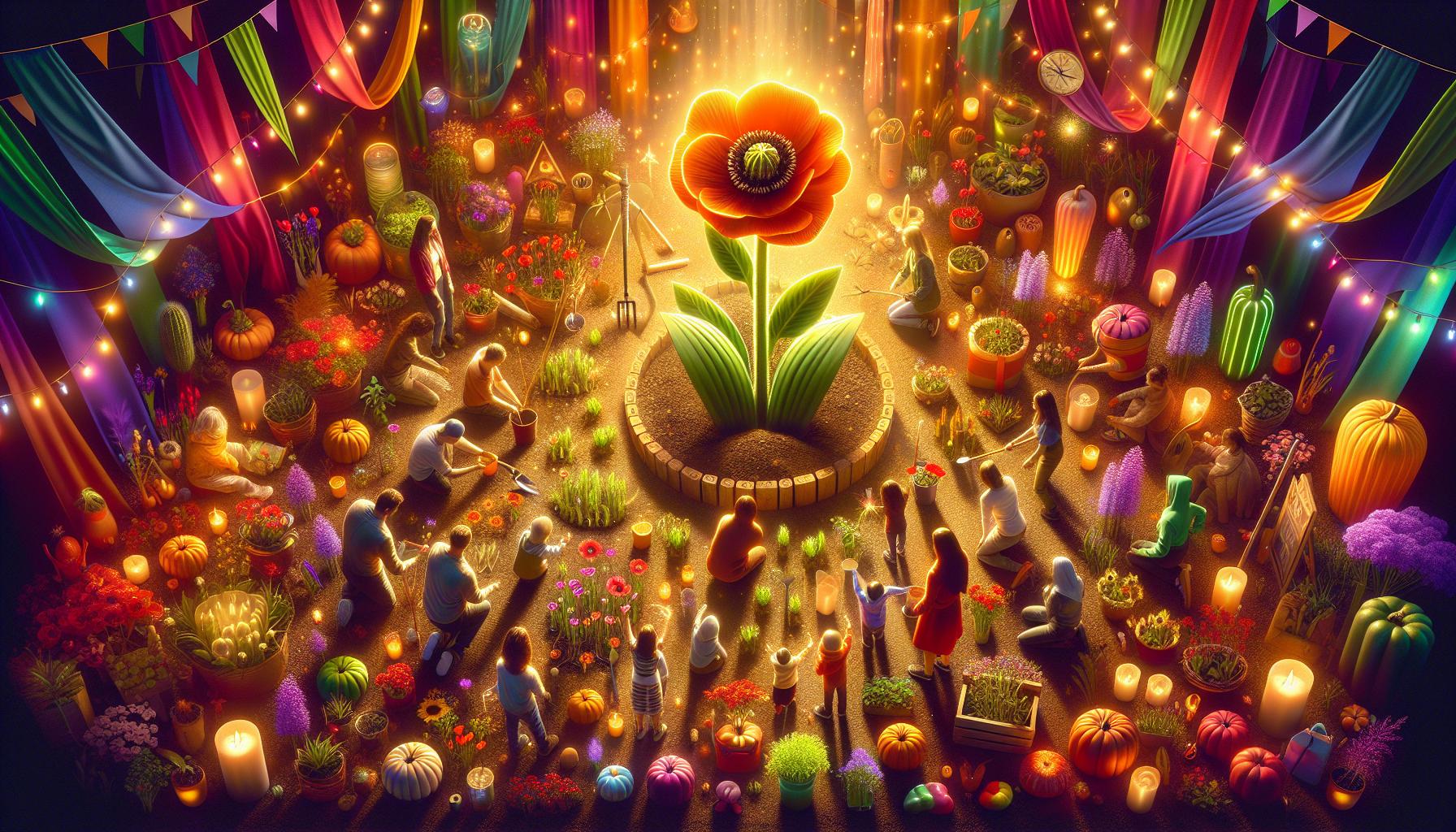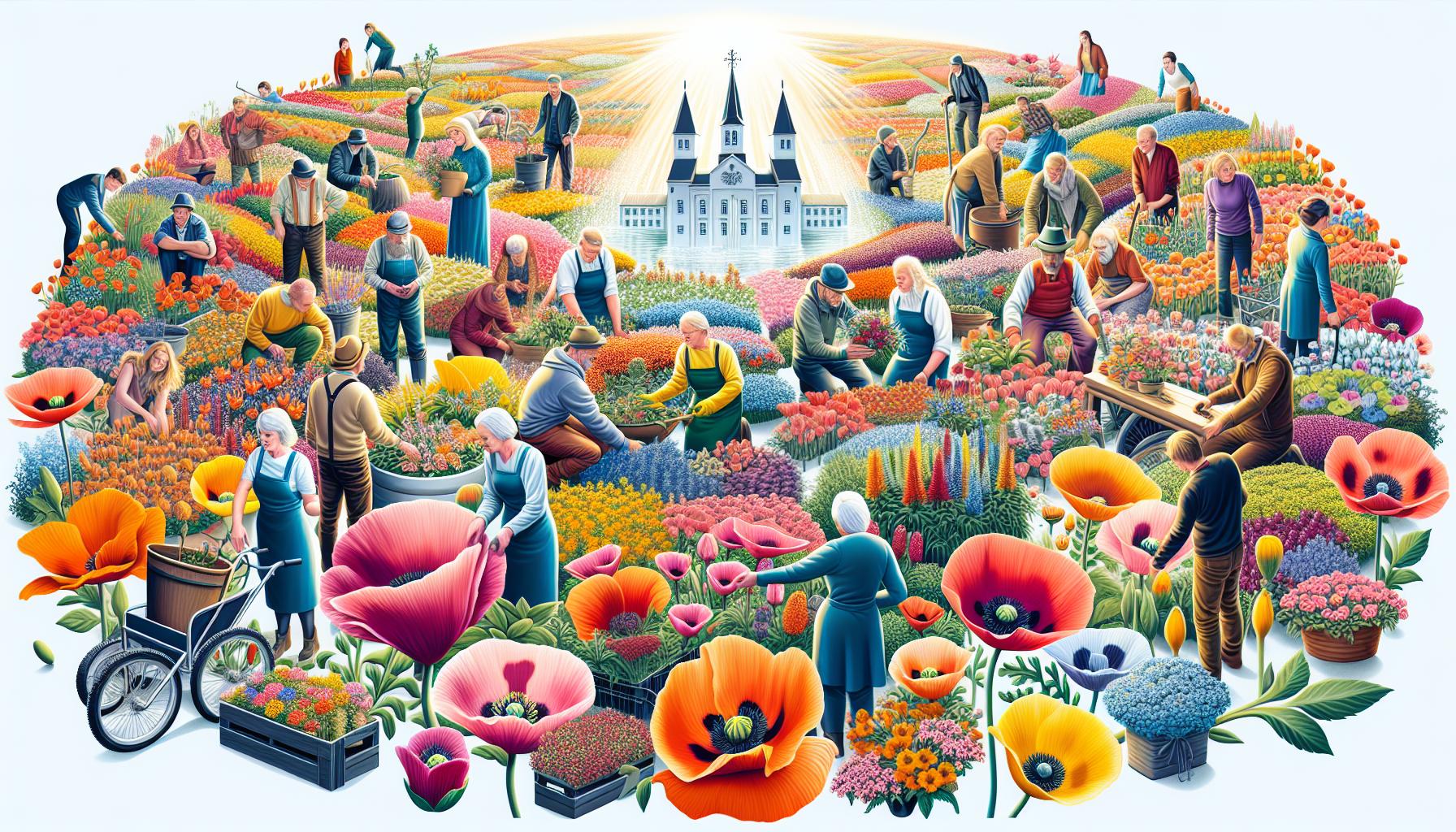Are Iceland poppies a fleeting beauty or a lasting garden companion? This vibrant flower captivates with its stunning colors and delicate petals, but many gardeners wonder whether it will return year after year. Understanding their perennial nature is crucial for anyone looking to create a flourishing landscape. This guide will help you grow and care for these enchanting blooms effectively.
Understanding Iceland Poppies: A Charming Floral Addition to Your Garden
Iceland poppies, with their stunning, delicate petals resembling tissue paper, offer a vibrant array of colors that can enhance any garden. These charming flowers thrive in various climates, showcasing their resilience and adaptability. With proper knowledge of their growing conditions and care requirements, gardeners can successfully cultivate these perennials and enjoy their beauty season after season.
Growth Conditions
To provide the best environment for Iceland poppies, consider the following essential cultivation tips:
- Soil: These poppies prefer well-draining soil rich in organic matter. A sandy or loamy texture is ideal to prevent waterlogging.
- Light: Abundant bright light is crucial, as these flowers flourish best in full sun, ideally receiving 6-8 hours of sunlight daily.
- Watering: While Iceland poppies need regular moisture, it’s important to water them minimally; overwatering can lead to root rot.
- Temperature: They are cold-hardy and can endure frost, making them suitable for early spring gardens.
Planting and Care
Starting Iceland poppies can either be done from seeds directly sown into the garden in early spring or by transplanting seedlings. If you opt for seeds, ensure that they are lightly covered with soil, as they require light to germinate. Once established, these flowers need minimal maintenance, but a few practices can enhance their growth:
- Deadheading: Regularly remove spent blooms to encourage new flower production and prolong the blooming period.
- Fertilizing: Applying a balanced, slow-release fertilizer at the beginning of the growing season can boost growth and flowering.
- Mulching: Adding a layer of mulch helps retain soil moisture and suppresses weeds.
With their captivating beauty and ease of care, Iceland poppies are indeed a charming floral addition for any garden enthusiast. By following the guidelines outlined in our “Are Iceland Poppies Perennials: Growing Guide & Care Tips,” you’ll be well on your way to enjoying these delightful blooms throughout their growing season.
Lifespan of Iceland Poppies: Are They Truly Perennials?
The Iceland poppy is a captivating flower known for its vibrant colors and delicate, translucent petals, making it a favorite among gardeners and flower enthusiasts alike. However, many people wonder about the longevity of these stunning blooms, questioning whether they are reliable perennials or simply annuals with a fleeting presence. Understanding the lifespan of Iceland poppies is essential for anyone looking to incorporate these beauties into their garden landscape.
Are They Perennials or Annuals?
Iceland poppies (Papaver nudicaule) are often viewed as short-lived perennials in some regions but are more accurately considered biennials or tender perennials. Here’s a clearer breakdown of their lifecycle:
- Biennial Nature: Typically, these flowers grow their foliage in the first year and bloom in their second year. After blooming, they may self-seed, allowing new plants to emerge in future seasons.
- Hardiness Zone: Depending on the climate, their behavior can vary. In USDA hardiness zones 3 through 7, they tend to return for several seasons, sometimes behaving like true perennials.
- Growing Conditions: Their lifespan can be influenced by factors such as soil quality, water availability, and exposure to harsh winter temperatures. In regions where winters are mild, they may last longer than in areas with severe frost.
Factors Influencing Longevity
Several factors dictate whether your Iceland poppies will thrive as perennials or fall short after a season or two:
| Factor | Impact on Lifespan |
|---|---|
| Soil Quality | Well-draining, rich soil promotes healthier plants that may return annually. |
| Climate | Moderate climates encourage longer lives; harsh winters can stunt growth. |
| Watering | Consistent watering without waterlogging supports robust plants. |
| Sun Exposure | Full sun exposure is ideal; too much shade can reduce flowering. |
To encourage Iceland poppies to flourish and maximize their lifespan, gardeners should focus on creating optimal growing conditions. This means selecting a well-draining location, particularly in sandy or loamy soils, and ensuring they receive plenty of sunlight throughout the day. In regions prone to extreme weather fluctuations, it might be beneficial to mulch around the plants to protect their roots during winter months. With the right care and conditions, these beautiful blooms can indeed behave like perennials, delighting your garden with their colors year after year.
Ideal Growing Conditions: Where and How to Plant Iceland Poppies
When planning a vibrant and captivating garden, the Iceland poppy stands out as a stunning choice. Known for their delicate petals and cheerful colors, these flowers can add a touch of elegance to any landscape. However, to truly thrive, Iceland poppies require specific growing conditions that cater to their unique preferences. Understanding where and how to plant these beauties will set the foundation for a glorious display during their blooming season.
Optimal Growing Environment
Iceland poppies (Papaver nudicaule) flourish best in regions with a cool climate, making them ideal for temperate zones. They prefer full sun exposure, which means they should ideally receive at least 6 to 8 hours of sunlight per day. However, they can tolerate partial shade, particularly in hotter climates, where the afternoon sun could scorch their delicate blossoms.
The soil type is equally important for the healthy growth of these flowers. Here are some essential requirements:
- Well-drained soil: Iceland poppies are susceptible to root rot if kept in overly wet conditions. Ensure the soil has excellent drainage by incorporating organic matter like compost or peat moss.
- pH level: They prefer a slightly acidic to neutral pH, ideally between 6.0 and 7.0.
- Soil texture: A light, sandy loam is perfect for their roots to establish effectively.
Planting Techniques
To cultivate Iceland poppies successfully, timing and technique are key. Planting can be performed in early spring or late summer. Here’s a concise guide on the planting process:
| Step | Description |
|---|---|
| 1. Prepare the soil | Loosen the soil to a depth of 12 inches and mix in organic matter to enhance texture and nutrient availability. |
| 2. Sow seeds | Scatter seeds on the surface of the soil, as they require light to germinate—do not bury them. |
| 3. Watering | Lightly mist the area after sowing, keeping the soil consistently moist until germination occurs. |
| 4. Thinning | Once seedlings are about 2 inches tall, thin them to 12 inches apart to prevent overcrowding for optimal growth and airflow. |
By adhering to these guidelines, gardeners can create an environment that not only supports the initial growth of Iceland poppies but also results in their lush, breathtaking blooms. Proper preparation and care are fundamental as you embark on your journey with these perennials, ensuring they flourish beautifully in your garden.
Care and Maintenance: Nurturing Your Iceland Poppies Through the Seasons
Iceland poppies, with their delicate, tissue-like petals and vibrant colors, can inspire a gardener’s passion throughout the growing season. While these charming flowers often captivate with their breathtaking beauty, nurturing them requires a keen understanding of their care needs throughout the year. Knowing how to maintain your Iceland poppies not only prolongs their blooming period but also enhances their overall vitality. Let’s explore the essential care and maintenance practices that will help your Iceland poppies flourish, no matter the season.
Spring: Awakening and Planting
As the frost begins to recede, spring is the perfect time to sow your Iceland poppy seeds. These hardy flowers thrive in well-draining soil, so preparing your garden bed ahead of planting is crucial. Start by:
- Tilling the Soil: Turn over the soil to a depth of 12 inches and mix in organic compost to enrich it with nutrients.
- Choosing a Sunny Spot: Iceland poppies adore sunlight, so select a location that receives at least 6 hours of direct light daily.
- Direct Seeding: Scatter seeds directly onto the soil surface and lightly cover them with a thin layer of soil. The seeds require light for germination, so avoid burying them too deep.
Summer: Watering and Deadheading
Once your Iceland poppies burst into bloom, summer care is vital for maintaining their beauty. As the weather warms up, these enchanting flowers need consistent moisture:
- Water Regularly: Keep the soil consistently moist but avoid waterlogging. Water in the early morning to help reduce evaporation losses.
- Deadhead Spent Flowers: Regularly remove faded blooms to encourage new growth and prolong flowering. This also helps prevent plants from diverting energy into seed production.
Fall: Preparing for Dormancy
As temperatures start to cool down, it’s time to prepare your Iceland poppies for dormancy. This is a key phase that many gardeners overlook:
- Reduce Watering: Gradually reduce watering in the fall as the plants slow their growth in response to cooler temperatures.
- Mulch Around Plants: Apply a layer of mulch to help insulate the roots from freezing temperatures, ensuring your poppies come back strong in the spring.
Winter: Protection and Pruning
Winter poses challenges for Iceland poppies, particularly in regions with harsh winters. However, with a few proactive steps, you can protect your plants:
| Action | Description |
|---|---|
| Cut Back Foliage | After the first frost, cut back any dead or damaged leaves to prevent pests and diseases. |
| Cover with Mulch | Apply an additional layer of mulch or straw for protection against freezing temperatures and to retain soil moisture. |
By following these seasonal care tips, you can ensure that your Iceland poppies not only survive but thrive throughout the changing seasons. A little attention goes a long way in transforming your garden into a breathtaking floral display, allowing you to enjoy the stunning beauty of these perennial treasures year after year.
Common Pests and Troubleshooting: Keeping Your Poppies Healthy
Iceland poppies are not just stunning additions to gardens; they can also face a variety of challenges that gardeners must be prepared to address. Understanding these potential issues will help ensure a thriving and vibrant display. As hardy perennials adapted to colder climates, these poppies can suffer from pests and diseases, but with proper care, most issues can be managed effectively.
Common Pests
Iceland poppies can attract a few pests, the most prevalent being aphids and slugs.
- Aphids: These tiny insects suck the sap from the leaves, leading to wilting and stunted growth. They may also produce a sticky residue known as honeydew, which can attract other pests.
- Slugs: They are particularly fond of young plants and can cause significant damage by feeding on the leaves and stems, creating ragged holes.
To effectively manage these pests, consider implementing natural solutions like introducing ladybugs for aphid control and using copper barriers or bait for slugs. Regularly inspecting the foliage for signs of pests will also help catch any infestations early.
Troubleshooting Common Issues
Despite their hardiness, Iceland poppies can face a few environmental challenges. Overwatering can lead to root rot, while insufficient sunlight may prevent them from blooming.
- Root Rot: Ensure the soil drains well to avoid water buildup around the roots. It’s best to water the plants only when the top inch of soil feels dry to the touch.
- Lack of Sunlight: Iceland poppies thrive in full sun (at least 6 hours a day). If they’re not getting enough light, consider relocating them to a sunnier spot in the garden.
To further enhance their resilience, choose a well-draining soil medium that mimics their native, rocky habitat. Incorporating organic matter like compost can boost soil health and improve drainage.
Conclusion
By proactively managing pests and environmental challenges, gardeners can ensure that their Iceland poppies flourish, providing spectacular blooms year after year. Keep these tips in mind as part of your comprehensive guide to growing Iceland poppies, and enjoy a vibrant garden that stands out in any landscape.
Seasonal Highlights: What to Expect from Your Iceland Poppy Blooms
Iceland poppies are a vibrant addition to any garden, celebrated for their stunning display of colors and delicate, ruffled petals. As one of the most captivating flowering perennials, they typically bloom during the spring and early summer, brightening up landscapes with their cheery hues of yellow, orange, and red. This seasonal spectacle creates a lively atmosphere, especially in cooler climates where these flowers naturally thrive.
Blooming Periods and Conditions
These flowers generally begin to bloom from late spring through early summer. Under optimal conditions, you can expect:
- Initial Blooms: Early blooms can start appearing as soon as the temperatures rise above freezing in spring.
- Peak Bloom: The height of their blooming season usually occurs from May to June, providing a stunning visual feast.
- Extended Viewing: In some areas, especially warmer climates, Iceland poppies may continue to bloom sporadically into the fall.
Their preference for well-drained, sandy soils and full sun allows them to flourish, making it important to choose the right location in your garden for optimal growth. If planted in shaded areas, the blooms may be fewer and less vibrant, leading to a lackluster display.
Care for Continued Blooms
To ensure a season filled with bountiful blooms, it’s essential to provide proper care throughout their growing period. Here are some practical tips:
- Watering: Keep the soil consistently moist during the initial growth phase, but be cautious of overwatering, as this can lead to root rot.
- Deadheading: Regularly remove spent blooms to encourage new flower production and maintain a tidy appearance.
- Fertilizing: A balanced fertilizer can help promote healthy blooms, applied sparingly during the active growing season.
With a bit of attention, Iceland poppies can produce a brilliant display that captures the beauty of your garden. Their ephemeral blooms serve as a reminder of nature’s splendor, making them a must-have for those looking to add a touch of charm and color to their outdoor spaces. Embrace their seasonal highlights, and let Iceland poppies transform your garden into a vibrant tapestry of colors.
Creative Uses: Incorporating Iceland Poppies in Your Landscape Design
Iceland poppies, with their delicate petals and vibrant hues, can transform any garden into a vivid palette of colors. These captivating flowers bloom in shades of orange, yellow, and white, often boasting fringed edges that add texture to your landscape. Their ephemeral beauty is accentuated by their ability to thrive in various conditions, making them a versatile choice for gardeners looking to incorporate a touch of elegance and drama into their outdoor spaces.
Accent Planting
One creative use of Iceland poppies is as accent plants in borders or beds. Their upright, slender stems and bright blossoms contrast beautifully with low-growing ground covers or shrubs. Consider placing them strategically among darker foliage, as their vibrant hues will pop against greens and browns, creating a visually striking landscape.
- Pair with Low-Height Plants: Combine them with shorter plants like pansies or thyme to create a dynamic layering effect.
- Maximize Color Contrast: Use Iceland poppies alongside deep blue or purple flowers for a stunning complementary color scheme.
Container Gardening
For those with limited space, Iceland poppies can thrive in containers, adding a splash of color to patios or balconies. Select pots that are deep enough for their root systems and filled with well-draining soil to foster health and vigor. Mixed containers can be particularly attractive; combine poppies with trailing plants like ivy or lush greenery for a fuller, more vibrant display.
Seasonal Displays
Utilizing Iceland poppies in seasonal displays also offers a unique opportunity for creativity. Spring blooms can be interplanted with early season flowering bulbs. Once the poppies begin to fade, you can transition to summer annuals, ensuring that your garden remains vibrant throughout the seasons.
| Season | Recommended Companion Plants |
|---|---|
| Spring | Bulbs (Tulips, Daffodils) |
| Summer | Sunflowers, Cosmos |
| Fall | Asters, Ornamental Grasses |
Incorporating Iceland poppies into your landscape design not only enhances aesthetic appeal but also enables you to showcase your creativity. Their adaptability and stunning visual appeal allow for endless possibilities, making them a delightful choice for any garden enthusiast.
Personalizing Your Poppy Patch: Varieties and Color Choices to Consider
Creating a visually stunning poppy patch can be as rewarding as it is delightful. With Iceland poppies, known scientifically as *Papaver nudicaule*, you have an array of vibrant colors and unique varieties to choose from, ensuring that your garden can reflect your personal taste and style. These perennials are notable not just for their brilliant blooms but also for their delicate, feathery foliage that complements any outdoor setting beautifully.
Color Choices for Iceland Poppies
Iceland poppies come in a dazzling spectrum of colors that can brighten any garden space. From soft pastels to vibrant hues, the available varieties allow you to customize your landscape effectively. Consider incorporating:
- Yellow: Bright and cheerful, a perfect color for creating a sunny atmosphere.
- Orange: Provides a warm, inviting touch, ideal for fall-themed gardens.
- Red: Bold and dramatic, red Iceland poppies can serve as focal points.
- White: Offers a classic elegance, perfect for monochromatic designs.
- Pink: Adds a soft, romantic touch to borders and flower beds.
Combining these colors can yield stunning results. For example, pairing white and deep red can create a striking contrast that draws the eye, while pastels can lend a whimsical feel to your garden.
Popular Varieties of Iceland Poppies
When selecting your Iceland poppies, consider the different varieties, each offering unique characteristics. Here are a few to explore:
| Variety | Description |
|---|---|
| Champagne Bubbles | Features whimsical pastel petals, perfect for soft color schemes. |
| Royal Wedding | A stunning variety with large white blooms; ideal for elegance. |
| Sunshine Mix | A cheerful blend of yellows and oranges that brightens any garden. |
| Black and White | Stunning contrast with deep blacks and bright whites, great for visual impact. |
With these diverse options, gardeners can experiment and showcase their creativity. Whether you’re looking to create a serene escape or a bold statement, the right mix of Iceland poppies can enhance the beauty of your outdoor space delightfully. Consider your garden’s overall color scheme and themes when selecting the varieties and hues that will make your poppy patch uniquely yours.
Faq
Are Iceland Poppies Perennials?
Iceland poppies (Papaver nudicaule) are generally considered short-lived perennials, but many gardeners treat them as annuals. They grow beautifully in cooler climates and can reappear, but their longevity heavily depends on growing conditions and care.
These lovely flowers thrive in well-drained soil and full sunlight. While they can come back after winter, they may need some help from gardeners in warmer regions. To maximize their lifespan, consider following our growing guide for optimal care techniques.
How to Grow Iceland Poppies?
Growing Iceland poppies is quite simple! They prefer cool temperatures and well-draining soil. Start seeds indoors or directly in your garden, ensuring they get full sunlight for most of the day.
After the last frost, you can sow seeds directly into your garden. Sprinkle them lightly on the soil and gently press them in. Water them consistently for the best results. To encourage more blooms, deadhead spent flowers regularly, promoting a longer flowering period.
Why Does My Iceland Poppy Keep Dying?
If your Iceland poppy is dying, it may be due to several factors, such as overwatering, insufficient sunlight, or poor soil conditions. These plants prefer well-draining soil and can suffer from root rot if they sit in waterlogged conditions.
Evaluate their growing environment: ensure they are planted in a sunny area and the soil is not retaining too much moisture. Additionally, consider adjusting your fertilization routine—too much fertilizer can lead to weak growth. Following our care tips can help prevent these issues.
Can I Grow Iceland Poppies in Containers?
Yes, you can successfully grow Iceland poppies in containers! Using a large pot with adequate drainage holes will provide the space they need to thrive. Fill the container with a quality potting mix that allows for excellent drainage.
Make sure to place your container in a sunny location, as these flowers need lots of light to flourish. Remember to water them regularly but avoid overwatering to prevent root issues. Container gardening can add a splash of color to patios or balconies.
When Do Iceland Poppies Bloom?
Iceland poppies typically bloom in late spring to early summer, depending on their growing conditions. This lovely display can last for several weeks, particularly if you continue to encourage blooming through deadheading.
Ideal blooming conditions include cooler temperatures, so try to plant them where they receive morning sun but some shade during the hottest part of the day. With proper care, they can produce bright, cheerful blooms that enhance any garden or landscape.
Do Iceland Poppies Self-Seed?
Yes, Iceland poppies can self-seed if conditions are right. Once the flowers have bloomed and dried, their seeds can scatter, allowing new plants to grow in the following season.
This natural process can be quite beneficial for maintaining a vibrant garden display year after year. Just make sure to manage their growth by thinning the seedlings as they develop to prevent overcrowding, ensuring each poppy has enough space to flourish.
Can Iceland Poppies Survive Winter?
Iceland poppies can survive light winters but may not thrive in areas with severe cold. In regions with harsher winters, it is often best to treat them as annuals or provide winter protection.
To help them through colder months, consider adding a layer of mulch around the base to insulate the roots. If you live in a milder climate, these flowers may return in spring, brightening your garden once again!
Wrapping Up
As we conclude our vibrant exploration of Iceland poppies, it’s clear these stunning blooms can add a joyful splash of color to any garden—if you treat them right! Think about the tactile pleasure of their delicate petals brushing against your fingers or the burst of warm hues lighting up your landscape; their beauty is truly captivating.
Remember, while these poppies may not be true perennials, with proper care and a little love, they can surprise you with their resilience and annual returns. Just picture yourself in your garden, whispering words of encouragement as they stretch towards the sun, or perhaps sipping coffee on a warm afternoon, admiring the artistry of nature unfolding in your own backyard.
For those who dream of travel, let the spirit of Iceland inspire your next adventure. Whether it’s the fiery landscapes or gentle breezes wrapped in the nostalgia of local tales, the energy of this remarkable country offers boundless opportunities to explore and connect.
So why not dig deeper into the world of gardening and travel? Share your own stories and questions—let’s keep the conversations blooming! Together, we can nurture the longing for exploration and embrace the beauty that awaits, whether nestled in your garden or scattered across the glorious landscapes of Iceland or beyond. Happy gardening and wanderlust!






